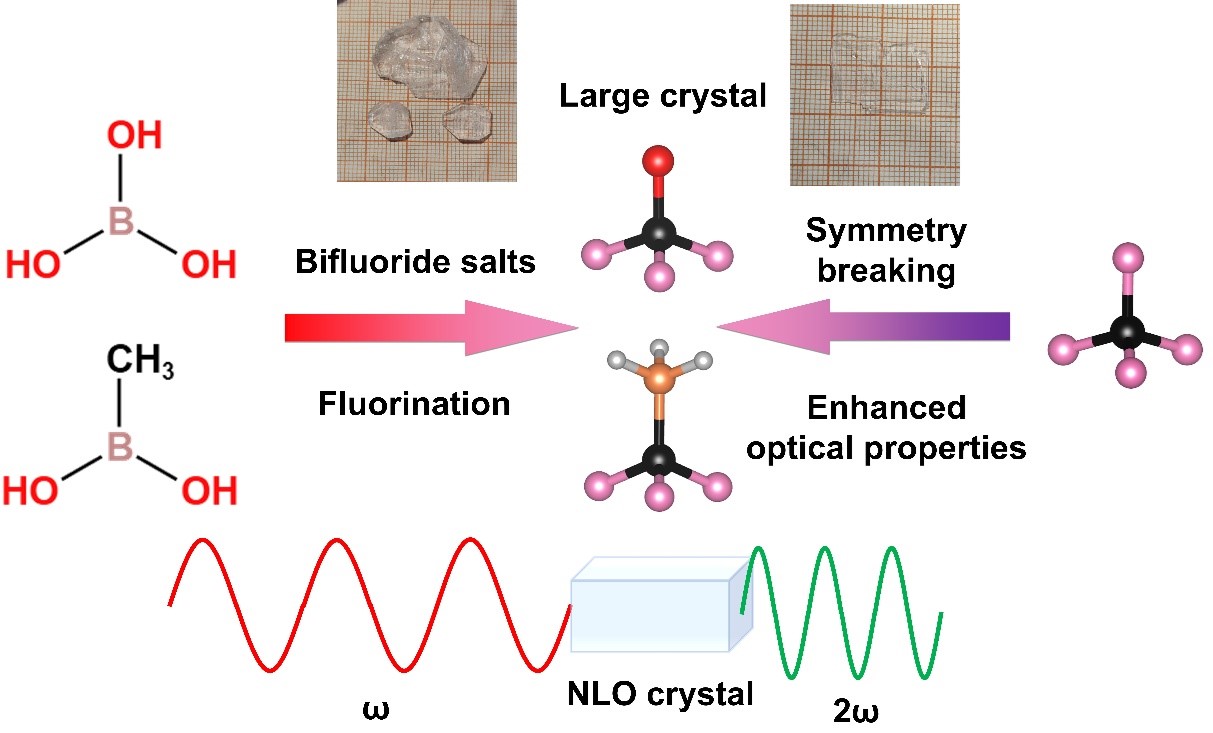Researchers propose fluorination strategy towards symmetry breaking of boron-centered tetrahedron for poly-fluorinated optical crystals
Editor: | Feb 26,2024
Borate composed of π- and/or non-π-conjugated boron oxyanions offers wide tunability of its optical and electrical properties. Modifying the properties of borates begins with the initial design of their anionic framework and cationic component. However, these component-level designs are only part of the story, as the way these anions and cations are arranged in the lattice determines the key properties of borates, with this heavily influenced by microelectronic arrangement in the lattice. For short-wave ultraviolet and deep ultraviolet borates, the main optical-active component is their anionic frameworks, wherein the π-conjugated [BO3] units with large hyperpolarizability, polarizability anisotropy, and HOMO–LUMO gap stimulated by the delocalized π electrons on all adjacent arranged p orbitals are the star primitives to design optical crystals.
Fluorination strategy allows for the chemical and functional modification of oxysalts, which promotes the discovery of fluorine containing compounds with a structure and property not found in other oxide parents. Therefore, fluoridation has long been important in chemistry and materials research, notably in the areas of medicine, battery materials, electrochemistry, and optical crystals.
The diverse structural chemistry of borates, a class of oxysalts, originates from the various ways in which [BO3] and [BO4] units are concatenated, giving rise to various physical and chemical properties. It has been discovered that fluorine might gradually replace oxygen atoms in [BO4] of borates, generating three novel fluorinated units, namely mono-fluorinated [BO3F], di-fluorinated [BO2F2], and trifluorinated [BOF3] tetrahedra, with the help of mixed anion engineering and a fluorination method in oxysalts. Fluorooxoborates, which have potential in the realm of ultraviolet (UV) and deep-ultraviolet (deep-UV) optical crystals, are borates that contain such primitives. Fluorination strategy allows for the chemical and functional modification of borate crystals, which promotes the discovery of newly fluorooxoborates. Significantly, more than two thirds of the reported fluorooxoborates contain [BO3F], around one third contain [BO2F2], and less than 4% had [BOF3], highlighting the rarity of the poly-fluorinated [BOF3] motif.
The majority of the time, a rather tight environment is necessary to prevent the volatilization of fluorine when we are worried about the synthesis of fluorooxoborates. Additionally, the majority of fluorooxoborates have lower thermal stability than anhydrous borates that simply contain the B-O groups, which places constraints on the melting and decomposition points of boron and fluorine sources. Most current synthesized fluorooxoborates rely on the metal or non-metallic fluorides as well as the corresponding tetrafluoroborates, whereas bifluoride salts are infrequently utilized, especially for anhydrous fluorooxoborates.
Based on this, a research group led by Prof. Shilie Pan and Miriding Mutailipu at Xinjiang Technical Institute of Physics & Chemistry, Chinese Academy of Science, reported the use of bifluoride salts as a potent source of fluorine to create fluorooxoborates. With this in mind, a total of 11 compounds were discovered. All fluorinated products are synthesized by the simple, energy-efficient, and highly effective process of hydrogen fluoride salts and boric acid or methylboric acid solution spontaneous nucleation. The successful fluorination of both inorganic and organic boron compounds using this synthesis method was successfully reported for these series. Additionally, the authors identified the optical properties of the organofluorinated group [CH3BF3] and their potential, as well as the associated characteristics of the corresponding compounds. Additionally, the mixed anion technique and the anion replacement strategy were used to successfully synthesize two isomorphic examples of non-centrosymmetric nitrates. They hold potential for the production of 266 nm harmonic coherent light for nonlinear optics, and more crucially, have the benefit of growing large size single crystals.
The paper was published on Angew. Chem. Int. Ed. 2024, 63, e202316194 with the title of “Fluorination Strategy Towards Symmetry Breaking of Boron-centered Tetrahedron for Poly-fluorinated Optical Crystals”. This work was financially supported by National Key R&D Program of China, Young Elite Scientist Sponsorship Program by CAST, National Natural Science Foundation of China, and the West Light Foundation of CAS.

Figure: Schematic diagram of design and preparation strategy for preparing this series of fluorinated products.
附件下载:
 (86) 991-3838931
(86) 991-3838931 lhskj@ms.xjb.ac.cn
lhskj@ms.xjb.ac.cn (86)991-3838957
(86)991-3838957 40-1 Beijing Road
Urumqi, XinjiangChina
40-1 Beijing Road
Urumqi, XinjiangChina